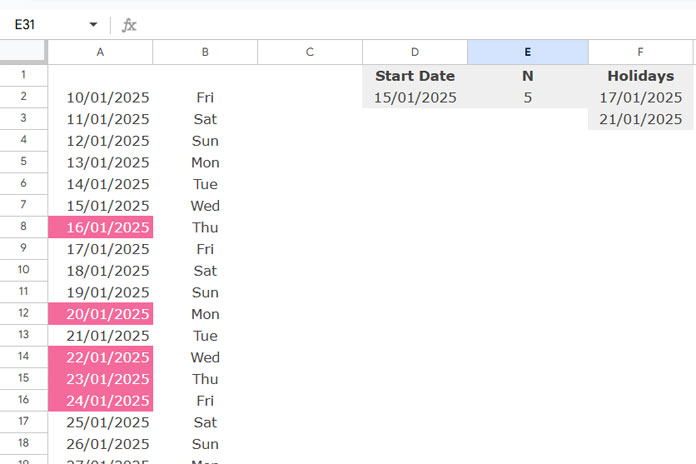You can use a combination formula with WORKDAY.INTL as the key function to highlight the next N working days from a specific date in Google Sheets.
This formula requires you to specify:
- The number of business days to highlight.
- The weekends.
- Any specific holidays to exclude.
These details will be incorporated into the formula, as explained below.
How Highlighting Next N Working Days Is Useful
Sometimes, you may need to commit to clients or stakeholders that you’ll complete tasks within the next 3, 7, or 10 working days from a specific date.
In such cases, you might want to highlight rows in your dataset where the task dates fall within the next N working days. Working days exclude weekends and holidays, making this functionality especially useful for accurate scheduling.
Example: Highlighting Next N Working Days
Assume the list of dates is in column A2:A.
- Enter the specific start date in D2. This could be
=TODAY()or any other date. - In E2, input the number of business days to highlight (e.g., 5).
- Use F2:F to specify holidays to exclude from the highlighting.

Now, use the following custom formula in conditional formatting:
=AND(
ISBETWEEN(
A2,
WORKDAY.INTL($D$2, 1, "0000011", TOCOL($F$2:$F, 1)),
WORKDAY.INTL($D$2, $E$2, "0000011", TOCOL($F$2:$F, 1))
),
NOT(ISNUMBER(XMATCH(WEEKDAY(A2, 2), {6; 7}))),
NOT(ISNUMBER(XMATCH(A2, TOCOL($F$2:$F, 1))))
)This formula highlights the next 5 business days from the date in D2, excluding the holidays in F2:F. Here, “0000011” defines Saturday and Sunday as weekends.
Applying the Rule
- Select the range A2:A (the dates to be highlighted).
- Go to Format > Conditional formatting.
- Under Format rules, choose Custom formula is and paste the formula above.
- Select your preferred formatting style and click Done.
Now, the specified range will highlight the next N working days.
Customizing Weekends in the Formula
The formula uses a string to specify weekends within the WORKDAY.INTL function. The string contains seven characters where 0 represents a workday and 1 represents a weekend. For example:
"0000011": Saturday and Sunday as weekends."0000110": Friday and Saturday as weekends.
If you change the weekend string, remember to update:
- Both occurrences of WORKDAY.INTL in the formula.
- The array constants
{6; 7}for the weekend days. For example, if your weekends are Friday and Saturday, replace it with{5; 6}.
Here’s the updated formula for Friday and Saturday weekends:
=AND(
ISBETWEEN(
A2,
WORKDAY.INTL($D$2, 1, "0000110", TOCOL($F$2:$F, 1)),
WORKDAY.INTL($D$2, $E$2, "0000110", TOCOL($F$2:$F, 1))
),
NOT(ISNUMBER(XMATCH(WEEKDAY(A2, 2), {5; 6}))),
NOT(ISNUMBER(XMATCH(A2, TOCOL($F$2:$F, 1))))
)How the Formula Works
Logical Expression 1:
ISBETWEEN(A2, next_n_start, next_n_end)WORKDAY.INTL($D$2, 1, "0000011", TOCOL($F$2:$F, 1)): Calculates the start date of the next N working days.WORKDAY.INTL($D$2, $E$2, "0000011", TOCOL($F$2:$F, 1)): Calculates the end date of the next N working days.- ISBETWEEN checks if the date in A2 falls within this range.
Logical Expression 2:
NOT(ISNUMBER(XMATCH(WEEKDAY(A2, 2), {6; 7})))Returns TRUE if the date in A2 is not a weekend.
Logical Expression 3:
NOT(ISNUMBER(XMATCH(A2, TOCOL($F$2:$F, 1))))Returns TRUE if the date in A2 is not a holiday.
If all conditions are TRUE, the formula highlights the cell.
Resources
- Highlight Duplicate Values Based on Occurrence Days in Google Sheets
- Highlighting Today and N Cells Below in Google Sheets Calendar
- Highlight Upcoming Birthdays in Google Sheets
- Finding the Last 7 Working Days in Google Sheets (Array Formula)
- How to Find the Last Working Day of a Year in Google Sheets
- Find Number of Working and Non-Working Days in Google Sheets
- How to Find the Last Business Day of a Month in Excel



















